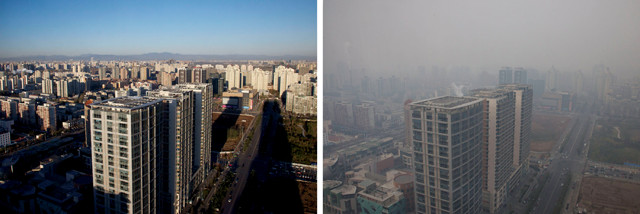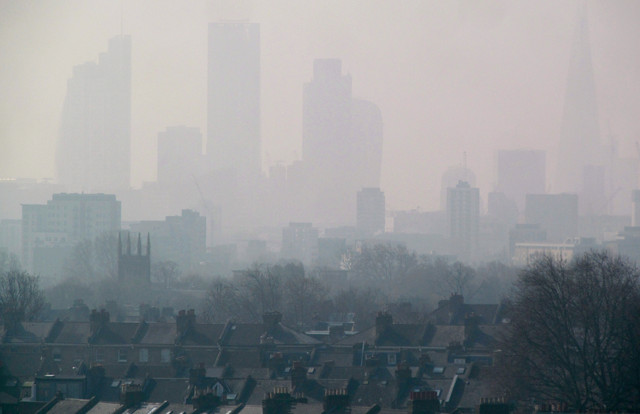
by Sarah Derouin Wednesday, November 15, 2017

A clear day versus a smoggy day in Beijing. Winter smog can be especially thick and visibility can be reduced to meters. Scientists have recently used smog in Beijing to better understand what happened in London in 1952. Credit: both: Peter Barwick, www.flickr.com/photos/barwick.
On Friday, Dec., 5, 1952, a blanket of thick, yellow smog settled over London, cloaking the city for five days straight. Smog wasn’t uncommon — Londoners called these days “pea-soupers,” based on the yellow-black color — and there were notable smog episodes from the Industrial Revolution (late 1700s) through the 1950s. But the haze of the city’s infamous “Great Smog” of 1952 long overstayed its visit. The lingering smog killed thousands, and its residual effects lasted for decades.
December in London usually means cold weather, and 1952 was no exception: A cold snap in November and early December brought a proliferation of coal burning — the conventional means of heating homes and businesses in London at the time — and the associated emissions. In fact, nearly all of the city’s 8 million residents relied on coal fires for warmth, and numerous coal-fired power plants also operated within the greater London area.
Coal, the compacted and concentrated remains of long-buried organic matter, is predominantly composed of carbon, but also contains varying amounts of impurities like nitrogen and sulfur. The proportion of carbon versus impurities is used to rank different coals: For instance, anthracite coal, which is 90 to 100 percent carbon and contains few impurities, is considered more valuable and burns more efficiently, producing a higher heat. On the other end of the spectrum, lignite (sometimes called brown coal) is only about 60 to 70 percent carbon and contains many impurities, including up to 3 percent sulfur, meaning it tends to release higher levels of noxious gases when burned. In 1950s London, most of the coal burned was on the lower end of the spectrum.
London sits within the Thames River Valley. In early December 1952, an anticyclonic high-pressure system settled over the region, centered over London. The resulting atmospheric conditions caused a layer of warm air to essentially cap cooler air at ground level, a phenomenon known as a temperature inversion.
The air remained stagnant for days, limiting the flow of venting winds in and out of the city. As hot smoke rose from chimneys, it bumped up against the warm capping air, trapping soot and gases over the city. On Friday, Dec. 5, that trapped smoke from millions of residential coal fires engulfed the city. Reports estimate the size of the smog cloud, at its largest extent, was almost 50 kilometers across and 60 meters thick.
By Saturday, conditions had worsened significantly: 500 people died in London that day. Once the ambulances — unable to navigate through the thick smog — stopped running, people staggered into the hospitals on foot. Patients’ lips were blue as they suffocated from the toxic smog. The elderly, children and those with compromised respiratory systems were especially vulnerable.
Two days after the smog hit, visibility in the city was less than an arm’s length. Cars were abandoned on roads — the drivers giving up on trying to navigate to wherever they were going. Looters and thieves took advantage of the smog to cover their getaways, robbing with impunity. The smog eventually seeped indoors, covering surfaces with a greasy black grime, and even sealed libraries had reports of archivists rounding corners to find a pocket of smog swirling within the stacks. At hospitals, “you couldn’t actually see from one end of the ward to the other, and it’s not that enormous a length,” said Maureen Scholes, a nurse who worked at the Royal London Hospital, in an interview with the BBC.
In addition to the haze of dark particulates swamping the air, tiny droplets of sulfuric and hydrochloric acids floated amid the sea of smog, burning the eyes, throats and lungs of Londoners.
Sulfur dioxide gas is a common byproduct of burning coal; in the atmosphere, the gas is oxidized to sulfate and combines with water to form sulfuric acid. That much has been known for a long time, but until recently, it was unclear just how these acidic clouds formed so quickly and persisted as long as they did.
Surprisingly, the answer came from data collected on the other side of the world nearly 65 years after the Great Smog. Renyi Zhang, an atmospheric scientist at Texas A&M University, and his colleagues were studying the haze that overwhelms megacities in China. Specifically, Zhang’s team was trying to figure out why smog over Beijing has such a high concentration of sulfates.
“It’s a combination of meteorology and chemistry,” Zhang said in an article about the research. The team found that certain atmospheric conditions are conducive to the formation of sulfuric acid hazes more rapidly than other mechanisms: specifically, high humidity and the presence of nitrogen dioxide. As sulfur dioxide and nitrogen dioxide — both common gases produced when coal burns — react with atmospheric water, sulfate particles can form and produce acidic haze.
Usually, the reaction would reach a threshold at which the haze gets so acidic that additional sulfate formation is shut down. But in China, the additional presence of ammonia in the air from agriculture and insufficiently treated sewage neutralizes the sulfuric acid, encouraging the haze to continue to form while simultaneously reducing its toxicity.
Populations in 1950s London and modern China both burn a lot of coal, and their atmospheric conditions are strikingly similar. The difference has to do with the size of water droplets that formed in the air during humid conditions: Meteorological observations have shown that in China’s skies, water droplets tend to be tiny, whereas droplets in London’s famous fog were larger by up to two orders of magnitude compared to those in China. Sulfates that formed over London and dissolved into the fog were progressively concentrated as the water droplets gradually evaporated and the fog burned off. “All you evaporate is the water,” Zhang said, and in that way, “you make very concentrated sulfuric acid droplets.”
Without mitigating ammonia in the air to reduce the acidity of the smog, Londoners were exposed to days of concentrated sulfuric acid haze.
ve long days after the yellow smog first engulfed the city, a strong westerly wind cleared the air. During the event, it wasn’t clear just how many people were dying from the smog. “No one realized at the time that the [number] of deaths was increasing,” said Robert Waller, a doctor at St. Bartholomew’s Hospital in London during the Great Smog, to the BBC. It wasn’t until there was a shortage of coffins and flowers in the aftermath that residents started to realize the extent of the impact of the days-long smog. “The number of deaths per day during and just after that smog was three to four times normal,” Waller said.

London continues to struggle with low air quality, even today. This image was taken in April 2015. Credit: David Holt, CC BY 2.0.
About 4,000 people died either during the Great Smog or immediately after. Scientists estimate that between 8,000 and 12,000 people died from smog-related illness in the months after the toxic cloud cleared. Another estimated 25,000 people claimed sickness benefits as a result of the smog in the following year. As reported by the BBC, according to the General Register Office, 59 percent of deaths during the worst of the smog and 76 percent of the deaths the following week were people with preexisting respiratory problems.
As a result of the thousands of related deaths and the continued health effects on the survivors, the U.K. Parliament passed the 1956 Clean Air Act. The crux of the act was to reduce smoke pollution by stipulating that furnaces couldn’t spew “dark smoke” — created by burning low-quality coal and releasing particulates into the air — and by creating “smokeless zones” in the city. Residents in these zones had to switch their heating from coal to a smokeless fuel like gas or to electric power. Power stations were relocated to more rural areas, and cleaner coals, with less nitrogen and sulfur impurities, were burnt. Some resistance cropped up from both the government and residents — transitioning to smokeless fuel was expensive, and this fuel was less plentiful than lower-grade coal. But the health effects could not be ignored. Additionally, financial grants helped residents transition to cleaner-burning fuels.
Another toxic fog in 1962 killed an additional 750 Londoners, spurring politicians to revisit environmental and air-quality protections. And six years later, the 1968 Clean Air Act was passed, requiring taller chimneys for industries to better disperse air pollution. These measures resulted in reduced smoke pollution in the city and decreased sulfur dioxide levels.
Today, London is facing more pollution concerns, but the culprit is not sulfur dioxide. Instead, nitrogen dioxide in traffic exhaust is causing issues for public health. “London is thought to have the highest levels of nitrogen dioxide of any capital city in the European Union, with levels on some of London’s busiest roads … currently more than triple legal limits,” said Alan Andrews, a lawyer for environmental organization ClientEarth, in a BBC story. According to Andrews, an estimated 4,300 Londoners die each year as a result of air pollution.

The biggest air pollution concern today in London is nitrogen dioxide, primarily from vehicle exhaust. Credit: ©iStockphoto.com/Leo Patrizi.
In January 2017, London experienced a new level of bad air when air pollution levels surpassed levels in often-hazy Beijing. Levels of particulate matter in the air hit 197 micrograms per cubic meter, said to be a result of traffic pollution and wood-burning stoves and facilitated by cold, calm conditions over the city. Wood stove installation has boomed in the past five years — more than a million homes in Britain now have a wood-burning stove — as a way to save on heating costs.
The result of the cold snap and calm air meant that parts of London were put on the highest warning level for pollution. Just a month earlier, London’s mayor, Sadiq Khan, had doubled funding to support clean air efforts, pledging an £875 million investment that will largely be used to phase out diesel-only buses and decommission old taxis.
In a 2016 statement, Khan said, “With nearly 10,000 Londoners dying early every year due to air pollution, tackling poor air quality is a public health emergency that requires bold action. I want London to be a world leader in how we respond to the challenge of cleaning up our air.”
© 2008-2021. All rights reserved. Any copying, redistribution or retransmission of any of the contents of this service without the expressed written permission of the American Geosciences Institute is expressly prohibited. Click here for all copyright requests.